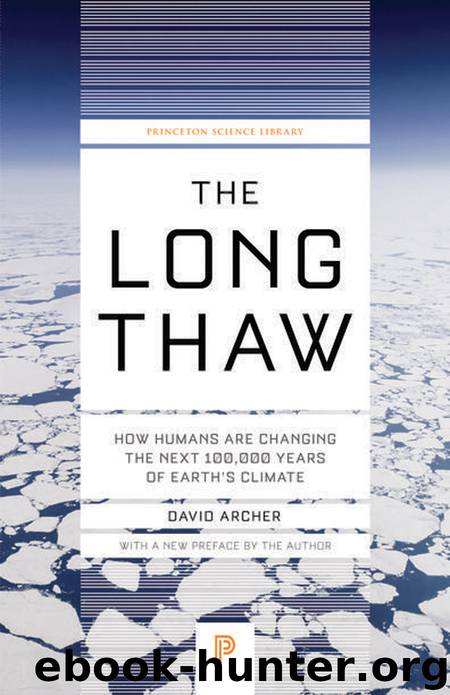The Long Thaw by Archer David; Archer David;

Author:Archer, David; Archer, David;
Language: eng
Format: epub
Publisher: Princeton University Press
Published: 2016-03-10T16:00:00+00:00
CHAPTER 7
The Present in the Bosom of the Past
The first question many people ask about the issue of human-induced climate change is how the forecast stacks up against natural variability and cycles in climate. Is global warming something big, or is it just nature-as-usual for the Earth? That question can now be answered by comparing the global warming forecast from Chapter 3 with past climate variations described in Chapters 4, 5, and 6. Even if you glazed over some of the marvelous details in those chapters, you should be able to jump back in here, reading this chapter as a sort of summary.
The impression I have is that global warming so far has been comparable to climate changes over the past millennium such as the Little Ice Age and the Medieval Optimum. In both cases, there have been regions where the climate changes are or were noticeable and harmful, but globally the impacts of the changes were subtle.
The potential climate change in the future is not subtle. If humankind burns all of the coal, the new climate of the Earth could be the warmest in tens of millions of years, since long before our evolution as a species. The transition from the natural climate to the new one could be the most severe global change since the Cretaceous / Tertiary boundary 65 million years ago that brought a close to the 150-million-year era of the dinosaurs.
The warming we have seen to date may be just noticeable to the man in the street, but it has certainly not been obvious for most of us. I’ve lived most of my life in the Midwestern United States, and I haven’t really noticed a warming trend over my lifetime, based on my own personal experience. I moved up to Chicago from central Indiana at some point, and that probably led to more climate change for me than the global change in temperature did. Summers in Bloomington got plenty hot decades ago, I’ll tell you what. The warming trend of the average Earth over the past decades is clearly measurable and it’s real. I’m not trying to belittle it. It is important as an indicator of future warming, and as a test for the climate models. But in the larger picture, the impacts of that warming have been subtle.
There have been regions of the Earth that have been harder hit, for example permafrosts in high latitudes and low-lying areas affected by sea level rise. Perhaps the strongest impact of climate change to most of us so far is the frequency of extreme climate events such as strong storms, rainfall, and heat waves. But overall, my subjective impression, maybe you don’t agree, is that the 0.7°C of warming that we have seen in our lifetimes has been measurable, and measurably harmful in places, but not really noticeable to most of us in our daily lives.
Climate change of the past few decades has been comparable to natural climate variations over the past millennium. A few centuries ago, from 1300 to 1860 A.
Download
This site does not store any files on its server. We only index and link to content provided by other sites. Please contact the content providers to delete copyright contents if any and email us, we'll remove relevant links or contents immediately.
Man-made Catastrophes and Risk Information Concealment by Dmitry Chernov & Didier Sornette(5637)
The Revenge of Geography: What the Map Tells Us About Coming Conflicts and the Battle Against Fate by Kaplan Robert D(3952)
Zero Waste Home by Bea Johnson(3646)
In a Sunburned Country by Bill Bryson(3359)
Good by S. Walden(3343)
COSMOS by Carl Sagan(3342)
The Fate of Rome: Climate, Disease, and the End of an Empire (The Princeton History of the Ancient World) by Kyle Harper(2858)
Camino Island by John Grisham(2714)
A Wilder Time by William E. Glassley(2686)
Organic Mushroom Farming and Mycoremediation by Tradd Cotter(2562)
The Ogre by Doug Scott(2495)
Human Dynamics Research in Smart and Connected Communities by Shih-Lung Shaw & Daniel Sui(2429)
Energy Myths and Realities by Vaclav Smil(2377)
The Traveler's Gift by Andy Andrews(2295)
9781803241661-PYTHON FOR ARCGIS PRO by Unknown(2267)
Inside the Middle East by Avi Melamed(2229)
Birds of New Guinea by Pratt Thane K.; Beehler Bruce M.; Anderton John C(2173)
A History of Warfare by John Keegan(2093)
Ultimate Navigation Manual by Lyle Brotherton(2043)
